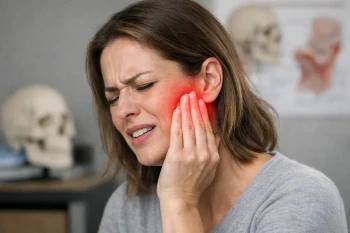
Over the past 18 years, we have been practicing the Blair upper cervical technique in Pleasanton, California. Over those 18 years, we have seen hundreds of concussion cases. Hyperacusis, or sensitivity to sound, is a common symptom experienced by post-concussion syndrome patients. However, post-concussion syndrome patients are not the only ones who have hyperacusis. We find about 5% of our new patients suffer from this phenomenon, and not all of them have suffered from post-concussion syndrome.
Hyperacusis, neck injury, sensitivity to light, and post-concussion syndrome seem to be highly correlated. This article would like to talk about our practice experience with patients who suffer from hyperacusis, sensitivity to light, and what it has to do with an upper cervical spine injury. The current scientific literature indicates that there is a correlation between concussion and hyperacusis.
A study published in 2018 showed concussed athletes compared to non-concussed athletes had higher levels of hyperacusis, more sensitivity to noise, losses in the upper ranges of hearing, and suffered from more depression. "Fifty-eight college athletes with normal hearing who either had incurred one or more sport-related concussions (N = 28) or who had never suffered a head injury (N = 30) participated. Results indicated that the Concussed group scored higher on the Hyperacusis questionnaire and displayed greater sensitivity to sounds in psychoacoustic tasks compared to the Control group"(1)
People who suffer from concussion have a higher incidence of hyperacusis than the regular population; however, current mainstream medical treatment does not have a successful protocol to help these patients recover from most Post-Concussion Syndrome.
Several studies indicate that hyperacusis after a concussion is one of the strongest indicators of whether a patient will have long term post-concussion syndrome symptoms—most people who suffer from a concussion recover in 7-10 days. However, a small percentage of individuals who suffer a concussion have long term health issues. Findings suggest that those who suffer from hyperacusis persisting past the second and third months have a poorer long-term prognosis. If a concussion patient suffers from hyperacusis into the third month following a concussion, they are three times as likely to have long term post-concussion symptoms. (2)
It appears that hyperacusis is related to head injuries. We would like to present an alternative view that may help shed light on this phenomenon and how it is related to an upper cervical spine injury. We have written many blogs in the past trying to raise awareness of the fact that concussion type injuries not only damage the brain, but simultaneously, they also injure the most vulnerable and neurologically important area of the body, the upper cervical spine, and brainstem. We believe that upper cervical spine injury is the determining factor that explains why some individuals who suffer from post-concussion syndrome do not recover and live with chronic health issues until they land in an upper cervical care office.
Neck Injury and Increased Sympathetic Activity of the Nervous System
The head-neck junction is the most vulnerable area of the spine when it comes to injury. The head weighs 10 to 12 pounds and rests on the atlas vertebra, which weighs 2 ounces. Furthermore, the headrests on the end of a "stick," making it susceptible to acceleration-deceleration type injuries. When a concussion injury occurs, it not only shears brain tissue, but it simultaneously tears the supporting soft tissue at the head-neck junction, which leads to a cascade of neurological effects.
The atlas (c-1) and axis (c-2) house the brainstem. The brainstem is the seat of control of almost all automatic functions in the body. The brainstem is the Pentium chip of the bod,y and upper cervical injury can irritate it and cause the nervous system to malfunction in a myriad of ways.
Increased sympathetic activity is a term used to describe the nervous systems overexcitability. Symptoms such as light sensitivity, anxiety, hyperacusis, tinnitus, and irritability are all signs that the central nervous system is overstimulated. This can occur due to spinal misalignment and subsequent irritation to the central nervous system.
It has been our experience that a high percentage of patients who suffer from hyperacusis respond favorably to Blair upper cervical technique. When a spinal misalignment is corrected in the upper cervical spine, it tends to "calm" the nervous system. One of the most common things patients say following upper cervical care is they are more relaxed, have better mental focus, and they handle stress better. This is due to the sympathetic nervous system coming back into balance with the parasympathetic nervous system.
What Exactly Does a Blair Upper Cervical Doctor Do?
Blair Upper Cervical doctors are specially trained to locate spinal misalignments in the upper cervical spine and correct them. Spinal misalignment is located by running a battery of neurological tests that locate the spinal segments that have been injured and misaligned by a prior neck injury.
Once located, precision imaging in the form of digital x-ray or cone-beam computed tomography (Cbct) is used to precisely determine which joint has misaligned and the angulation of the misaligned joint. Each person’s anatomy is different, and therefor,e imaging is used to uncover the blueprint to be used to correct each patient’s misalignment pattern.
Once this information is gleaned, a gentle, light correction is made without twisting, popping, or pulling. The patient is then monitored over time to ensure that the correction is holding. If the testing indicates the need for another correction, then it is performed. However, the goal of Blair Upper Cervical Care is for the patient to stay in “adjustment”.
It is not the correction that produces healing. It is the removal of nerve irritation and the adjustment “holding” in its normal position that allows the body to function better and proceed through a healing process. This is how Blair Chiropractic Care can often help remove the underlying cause of many who suffer from post-concussion syndrome, dizziness, tinnitus, hyperacusis, and other chronic health problems by supporting the body in healing itself.




Leave a comment